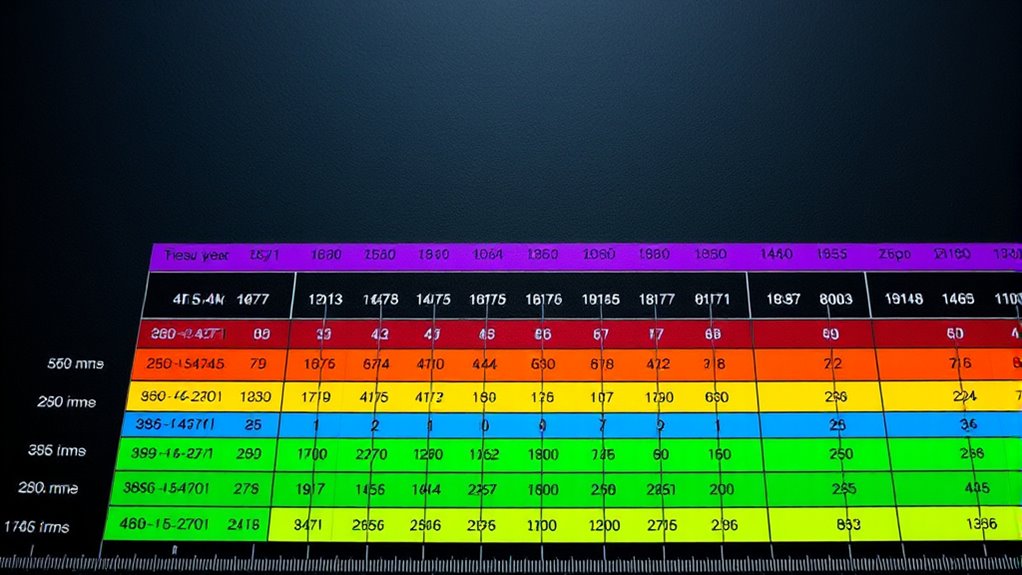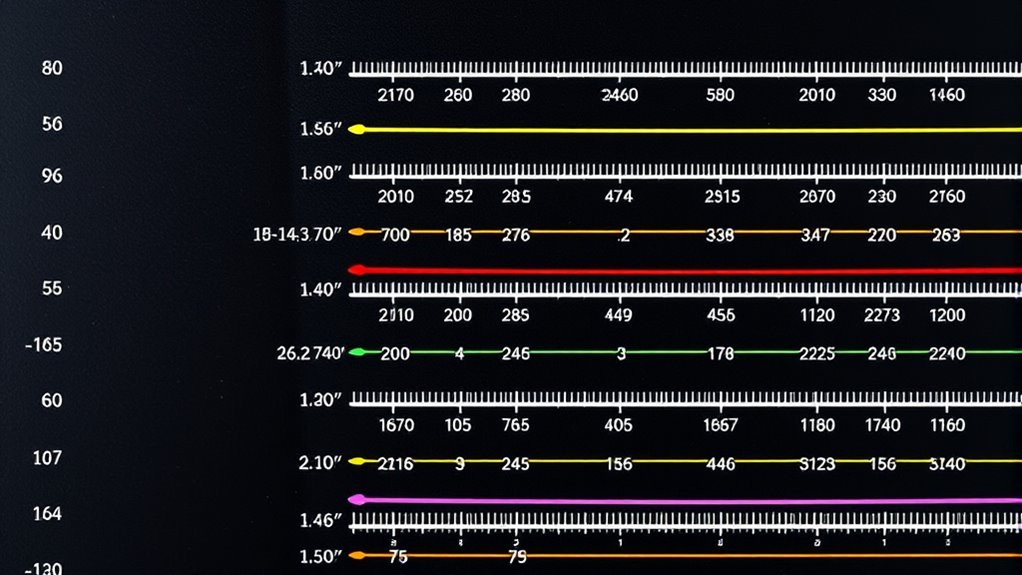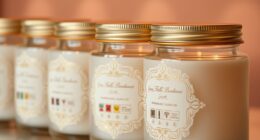To guarantee your candles burn safely and evenly, you need the right wick size based on your candle’s diameter, wax type, and container. An ideal wick prevents soot, flickering, tunneling, and uneven burn, making your candles look great and burn safely. Using a wick size chart makes selecting the perfect wick easier, saving you time and reducing mistakes. Keep going to discover more tips and details for perfect candle making.
Key Takeaways
- Match wick size to candle diameter, wax type, and container for optimal burn quality.
- Use a wick size chart to prevent tunneling, flickering, and soot issues.
- Select proper wick materials (cotton, wood, hemp) based on wax and safety requirements.
- Proper sizing ensures a steady, even burn and reduces fire hazards.
- Referencing a wick size chart saves time, minimizes waste, and improves candle safety and performance.

A wick size chart helps you quickly find the right wick size for your candles, ensuring ideal burn quality and safety. Choosing the correct wick size is vital because it directly impacts how your candle burns, how much wax melts, and how safe it is to use. An oversized wick can cause excessive flames, flickering, and soot, posing fire hazards. Conversely, a wick that’s too small might result in tunneling or incomplete burning, wasting wax and frustrating users. By using a wick size chart, you can match the wick to your candle’s diameter, wax type, and container, creating a safer and more enjoyable experience. Proper wick sizing also involves understanding candle safety principles to prevent hazards. When selecting a wick, it’s essential to understand candle safety. Proper wick sizing prevents issues like excessive flickering, uneven burning, or dangerous flare-ups. A well-chosen wick promotes a steady burn, reduces soot, and minimizes smoke, all of which contribute to a safer environment. The chart simplifies this process by offering clear guidance based on candle dimensions and materials, so you avoid trial-and-error methods that can lead to hazards. Another key aspect to consider is wick material comparison. Wicks come in various types, such as cotton, wood, hemp, or paper-core, each with different burning characteristics. Cotton wicks are popular for their clean burn and flexibility, while wood wicks produce a crackling sound and a larger flame, which may require a different wick size for safety. Hemp wicks are sturdy and tend to have a slower burn, demanding specific sizing to avoid uneven burning. The wick size chart helps you compare these materials and select the appropriate diameter for each type, ensuring a balanced burn that’s both safe and efficient. Using a wick size chart is especially helpful if you’re experimenting with different waxes like soy, beeswax, or paraffin. Each wax has unique melting points and burning properties, influencing how much wick you need. For instance, soy wax often requires a slightly larger wick to prevent tunneling, and the chart guides you through these nuances, saving you time and reducing waste. It also assists in understanding how wick size interacts with candle safety standards, helping you create candles that are not only beautiful but safe for everyday use.
Frequently Asked Questions
How Do I Measure Wick Size Accurately at Home?
To measure wick size accurately at home, start by choosing your wick materials, like cotton or wood, and then measure the diameter of your current wick with a ruler or caliper. Make certain your wick is straight and steady while measuring to get precise wick measurement. Keep in mind that different wick materials may require slight adjustments, so always test your wick size to ensure it burns safely and evenly.
What Materials Are Best for Different Candle Types?
Choosing wick materials is like selecting the right brush for a painting; it impacts your candle’s burn quality. For container candles, cotton or paper wicks work best, while wood wicks add a rustic touch to pillar candles. For soy or beeswax candles, use cotton or hemp wicks. Each candle type demands specific wick materials to make certain a clean, steady burn without tunneling or soot.
Can Wick Size Affect Candle Burn Time?
Wick size implications are vital because they directly affect burn time factors. If your wick’s too small, the candle may struggle to melt the wax evenly, leading to a shorter burn time. Conversely, a wick that’s too large can cause rapid burning and excess soot. Choosing the right wick size guarantees maximum burn time, a clean burn, and better candle performance overall. So, always match your wick to your candle’s size and wax type.
How Often Should I Trim My Candle Wick?
When it comes to trimming your candle wick, you don’t want to cut corners. Aim to trim it to about ¼ inch before each burn to prevent uneven burning or soot. Keep in mind that wick material choices and candle scent compatibility influence how often you should trim. Regular trimming keeps your candle burning smoothly—think of it as giving your candle a fresh start every time you light it up.
Are There Safety Tips for Selecting the Right Wick?
When selecting the right wick, you should follow safety precautions and selection tips to guarantee a safe burn. Always choose a wick suitable for your candle size and wax type, and avoid wicks that are too thick or thin. Check for quality materials and avoid metal-core wicks to prevent safety hazards. Properly centered and trimmed wicks reduce soot and fire risks, so follow these tips to enjoy a safe, clean burn every time.
Conclusion
Now that you’ve got this wick size chart, picture your candles glowing perfectly, each wick dancing in harmony with the wax’s warmth. Imagine the flicker of light casting gentle shadows, a steady flame that burns evenly and beautifully. Keep this chart handy—like a secret map—to guarantee your creations shine just right every time. With your new knowledge, your candles will glow with confidence, transforming simple wax into mesmerizing art.









